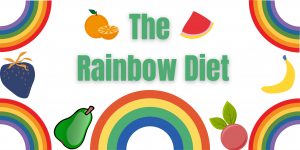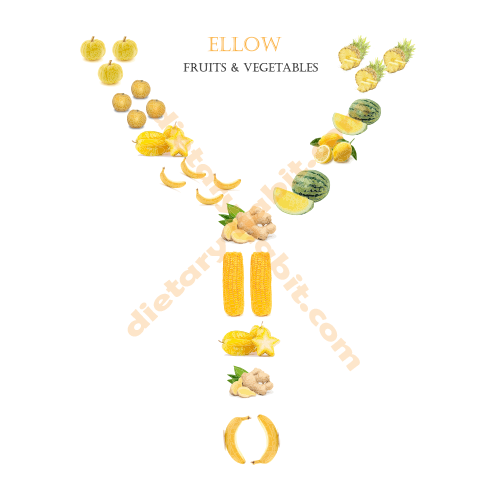Explaining The Rainbow Diet- WHATs, WHYs & HOWs

Though scientists are at odds on many issues, there seems to be little to no disagreement in admitting the benefits of eating fruits and vegetables. Whether raw or cooked, fruits and vegetables are scientifically proven beneficial to physiological and mental health. What makes them so inevitable in our daily diet? The colorful variations of fruits and vegetables come with a broader spectrum of nutrients. Properly supplemented, the rainbow diet foods can cover all the essential nutrients needed for our body. Build a habit of maintaining rainbow foods on your daily meal to gain the ultimate goal of a healthy lifestyle.
There’s no population surviving without plant-based foods from east to west and ancient to modern civilization. Nonetheless, certain communities entirely depend on fruits and vegetables to live by. Despite all the widely known benefits, most people’s dietary pattern shows something discouraging. The bitter truth is that most people fell short of the Recommended Dietary Allowance.
A research paper published in the Centers for Disease Control & Prevention (CDC) shows the plant-based dietary habits of American people from the data in 2015. The research suggests that almost 90% of them have a low intake of fruits and vegetables. Especially the men, young adults, and the poor class have poor access to the rainbow diet of fruits and vegetables. There’s no decent way other than taking a proper rainbow diet to eliminate the growing risks of chronic diseases. People suffer from many chronic disorders in the USA just because of unhealthy dietary habits.
What Is The Rainbow Diet
Rainbow food is a metaphorical term used to denote the array of vibrating colors found in fruits and vegetables due to the occupancy of different phytochemicals. The rainbow diet is just the diet that wants you to eat all the colorful fruits and vegetables in your daily meal by shuffling the varieties. So no more boring bland vegetables and pale-looking fruits in your diet chart. It’s time to add Rainbow Diet that includes multiple color choices in fruits and vegetables. Including a colorful rainbow diet in a cyclical order will boost your psychological gains and physical supremacy. Like the rainbow, fruits and vegetables have a diverse spectrum of colors covering most of the basic colors of a rainbow.
The Rainbow diet shows such colorful skin due to different phytonutrients. The differences of color pigments in various fruits and vegetables make them unique and precious from the perspective of essential nutrients. Phytochemicals have anti-inflammatory and anti-oxidative functions. These two actions are compulsories to maintain homeostasis in our bodies.
Our body constantly goes through an oxidative assault to burn food for energy. The antioxidant function keeps any negative impact at bay by neutralizing the assault. When there’s a disproportion between the production of free radicals and the stocks of antioxidants in our body, the condition is known as “oxidative stress.” This stage can occur due to both pathological and environmental causes. And only antioxidants can terminate the ill-behavior of free radicals. If free radicals are more than normal, they can damage the body at the cellular level.
Some other lifestyle and environmental factors also promote free radical production. For example-
- Normal metabolism in mitochondria
- Smoking
- Alcohol consumption & drug abuse
- Air pollutants
- Heavy exercise
- Inflammation
- Radiation hazards
- Pesticides
- Diabetes, Hypertension, Cancer, and other chronic diseases
All the factors above are directly linked with the production of excessive free radicals. But our body doesn’t contain enough antioxidants to resolve the situation immediately. So we need to supply enough antioxidants to function properly. To meet the demand, you need to include at least two servings of fruits and vegetables in your daily meal. Otherwise, it’s going to be a long fight between you and the chronic diseases. Free radicals also speed the anti-aging process.
What Are The Rainbow Foods
The color spectrum of the rainbow diet includes red or pink fruits and vegetables, blue or purple fruits and vegetables, orange fruits and vegetables, green fruits and leafy vegetables, and yellow fruits and vegetables. And lastly, you can’t ignore the white fruits and vegetables. All the fruits and vegetables altogether provide a great choice for us to pick them without boredom in eating. They have proved effects on mental health for their colorful characters.
To be noted, red fruits and vegetables are almost the same as pink fruits and vegetables. They share the same functions and contain practically the same phytochemicals. There’s the difference only in their density of colors. The same thing also goes for blue and purple fruits and vegetables, as the color density of flavonoids is slightly different.
Our blog has covered all the colorful fruits in the rainbow diet color spectrum. Hover into the titles and scroll through the in-depth articles to learn them thoroughly. Hopefully, you’ll find the best colorful food combo to add to your diet plan.
We’ve also covered the white fruits and vegetables if you want to know more. Pink lovers can go through the list of exotic pink fruits to learn detailed info about these fruits.
What Are The Benefits Of Eating The Rainbow Diet Foods
Why is it important to eat from the rainbow diet? Incorporating fruits and vegetables of all the color spectrum ensures the provision of all the essential phytonutrients. Moreover, the variations in their exotic appearance act as motivation to eat more healthy fruits and vegetables. Eating rainbow will help your habits grow.
Going Red
Red foods contain lycopene and other phytonutrients that have antioxidant and anti-inflammatory functions. They are useful in preventing chronic diseases, e.g., cancer, heart diseases, diabetes, etc. If you’re an outdoor person who works under the sun most of the time, red foods can help you as they prevent oxidative damages by UV rays.
Going Green
Green plants can produce their foods due to the ubiquity of green plastids. Green leafy vegetables and cruciferous vegetables offer more than only antioxidant and anti-inflammatory functions. Green leafy vegetables improve bowel health by facilitating the microbiome in the intestine. For chronic diseases like cancer, diabetes, cruciferous vegetables are more useful.
Going Yellow
Yellow foods are rich in carotenoids and zeaxanthin, which have antioxidant properties. But carotenoids are best known for their role in eye health. Carotenoids are the predecessor of vitamin A and produce retinol, retinal, to keep vision effective. They also play a principal role in maintaining youthful skin tone, and that’s why you’ll see them used in skin products in a great concentration.
Going Orange
Orange foods work more similarly than yellow ones, though they vary in the concentration of phytonutrients. Orange foods are also known as fat-cutter as they burn adipose tissue mainly in the upper abdomen. They filter UV rays from entering into eyes and thus protect the corneas.
Going Blue
Blue foods contain anthocyanin that gives them the blue color. Blue though resembles toxicity; hence blue is the blessings. They are crammed with antioxidants and anti-inflammatory nutrients. If you go blue in your diet menu, you’ll earn a healthy heart reducing the risks of growing different chronic diseases.
Last Words
Rainbow diet is running on trends, but all should follow a good trend if it serves the purpose of acquiring a healthier and merrier life. If you switch over the fruits and vegetables, you’ll avoid monotony and boringness in foods. Rather you’ll indulge in trying more different foods and enjoy their beauty. To research the availability of rainbow foods, you may make a chart that will help you buy the cheapest and the freshest rainbow foods right in the season and available in the market.


